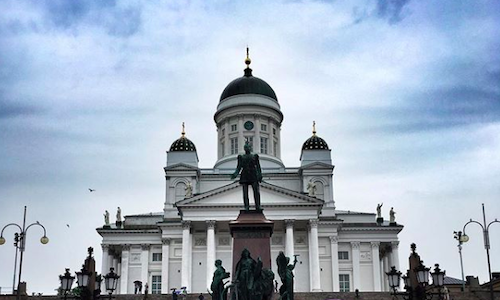Hello, Finnish capital! After a very peaceful 2,5 hours by bus from Tampere, we arrived to the Kamppi bus station in downtown Helsinki. It did not take long to find the Hotel Arthur – man, I really do not have any sense of distance when looking at a map! – which is conveniently located close to the train station, to the University and to the main Senate Square.
Our sense of time and space was stretched by the rain and our growing hunger while looking for a restaurant for lunch, but we realized quickly how small the heart of the city centre is: the Senate Square and the iconic Lutheran Cathedral are right behind the Market Square and the beautiful Esplanade, a large avenue lined with trees that turns into a narrow park, and the Uspenski Cathedral is right across the bridge from the Market Square.
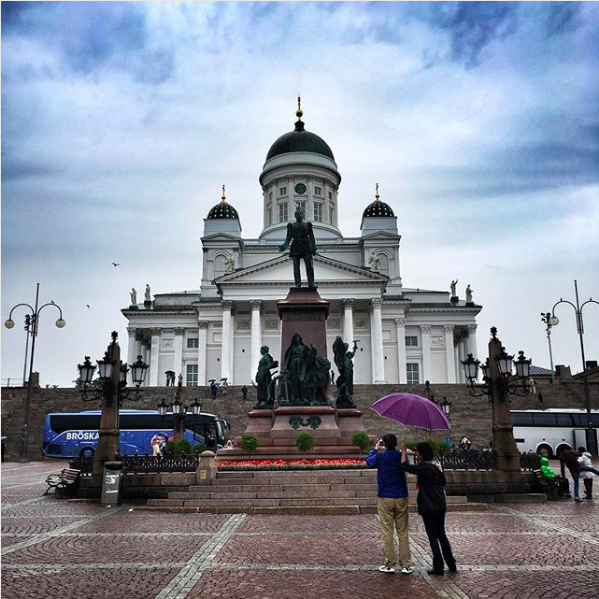
We ended up having a delicious burger at the Hard Rock Café, located on Alexanterinkatu street, the main one for shops and restaurants.
After our usual nap, at 5ish, we got ready to go to the Juhannus festival on Seurasaari Island. It is located west of the main peninsula, easily reachable with bus 24 in some 20 minutes.
The island hosts the Seurasaari Open Air Museum, a collection of houses from different periods and parts of Finland, all relocated in this beautiful and quiet forest to showcase how Finnish people lived in the past. For the Midsummer celebrations at the end of June – Juhannus in Finnish – a big folkloric festival takes place on the island, with typical food, activities for children and grownups, dancing and singing by locals wearing original costumes, and of course, burning of bonfires! I was afraid it was going to be a big tourist attraction, but it was actually packed with Finnish people, especially families with the blondest kids we’d ever seen.
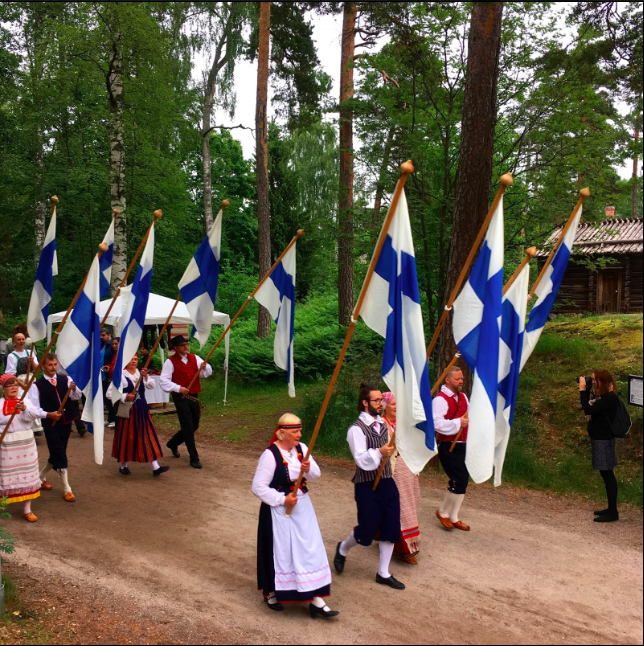
Even if the Open Air Museum was officially closed, we could still walk among the buildings, cute little villas and simple wooden huts, a church, a windmill and larger wooden farms from times past. On a quiet day, it must really give the feeling of travelling in time!
The atmosphere was very cheerful, girls were wearing flower crowns, delicious food smell reached us from everywhere, and along the main path we discovered the local arts and crafts. At a small playground I made myself ridiculous by trying to walk on two stilts and failing repeatedly: still, the best was watching my father succeeding at his first attempt, as it was a childhood game he used to play!
Unfortunately, all the explanations and speeches were in Finnish, so it was hard to follow what was happening. We watched some folk dances and a traditional Karelian wedding, ate small and expensive portions of fish and vegetables, watched one of the bonfires being lit.
Slightly bored, we went to explore the other side of the island, on the West, where we found a weird modern hut, admired the view of the sea, the city and the opposite shore: nothing mind-blowing, it’s a mix-and-match of residential areas, factory chimneys, forests, working sites with cranes… Still, it must be a lovely relaxing spot on a sunny day.
We enjoyed this relaxing evening, walking among the beeches and watching a squirrel run up and down the trees. At the beautiful traditional restaurant in the centre of the island we had a slice of cake, and then walked back to the eastern edge to watch the lighting of the main bonfires by the bride and groom at around 10pm. It took a while, but I must say it was quite evocative to see people wearing traditional costumes approaching by boat and lighting up this huge pile of wood, followed by the chanting of a poem by everybody on the island: it transmitted how strong this pagan tradition is and the important place is still occupies in the Finnish culture.
The celebration continued with singing and dancing, but we headed back to the city centre – there was a line of public buses waiting for the crowd at the exit, perfect organization!
Still energized by the white night and hungry, we walked along the beautiful Esplanade and ended up having another dessert at the iconic Kappeli restaurant and Café.
On the way to the hotel, the view of the imposing white Helsinki Cathedral over the whole city and under the timeless sky was simply magical.
Full day in Helsinki! We started with the Hop-on Hop-off bus – there are maybe 2-3 brands that follow the same itinerary, with 20 or 30 minutes frequency, so you can choose whichever you like according to your schedule (yay, the bus passes every 20 minutes! Wait, it means that when we get off, we have to hurry to catch the next one…).
We did not buy the Helsinki card because it was not convenient for our plans, but I read it has a lot of advantages and discounts, so it’s worth taking a look at.
My mum loves the convenience of the bus showing you the main sights and telling you the history of the city in the meantime, but if you don’t feel like spending 30 euros, there must be a scenic route by tram or public transport.
We left from Senate Square, a grand start. From the open bus, we could admire the diverse architectural styles of Helsinki, a quite young city, built mainly from the 19th century, when it became capital of the Grand Duchy, after numerous fires.
We got off the bus to have a walk in the pretty Kaivopuisto Park, surrounded by beautiful houses, facing a marina full of inviting sailboats. We hopped on and off again at the Rock Church, an incredible building that joins together the steady strength of natural rocks and a modern copper round roof whose beams let the light pour inside. It was absolutely packed, but apparently we were still lucky enough to enter without queueing. Despite the constant mumbling and buzzing, it was a very mystical experience.
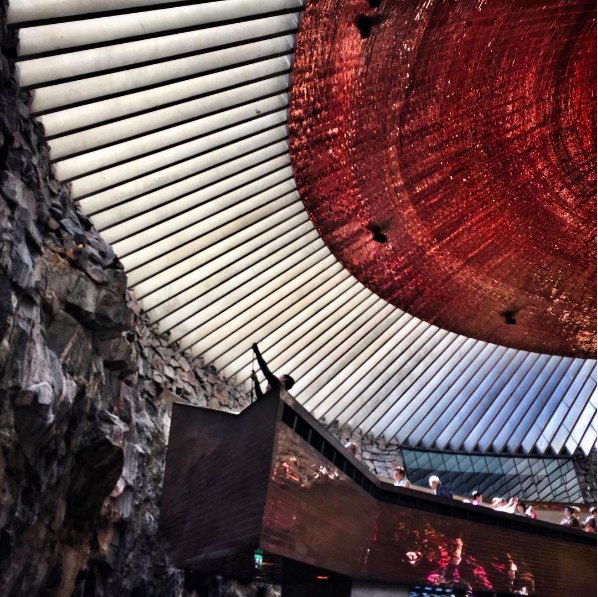
Our next stop was the Sibelius monument, quite north of the city centre. Johan Sibelius (1865-1957) is the greatest Finnish composer, whose music has helped Finland to develop a national identity during the struggle for independence from Russia. The Sibelius monument is a large, abstract sculpture designed by Eila Hiltunen, consisting of 600 steel pipes welded together in a representation of the wavy essence of Sibelius’ music. It is a very unique sight, it is possible to walk right under it and touch it. I read that the hollow pipes are supposed to blow some kind of music in the wind, but I guess it wasn’t windy enough. However, as it is quite outside of the city centre, I would not put it in the must-see list of Helsinki if you have only a day or two. Anyway, if you get there, make sure you walk down to the seaside and have a look at the Café Regatta, absolutely precious!
The last part of the bus tour brought us by the National Opera, the Finlandia Hall by Alvar Aalto, the National Museum, the Parliament (under restoration), and back to the Esplanade.
Overall, the bus ride showed us all the different architectural styles of Helsinki: the grand Neo-Classic of the Senate Square, so imperial and European; the Byzantine-Russian style of the Uspenski cathedral and other churches around town; the Art Nouveau (or Jugend) that is visible in small details almost everywhere, but is exemplified by the massive Central Train Station; some traditional wooden houses; functionalist residential areas; modernist landmarks by Alvar Aalto like the Finlandia Hall; and finally some contemporary pieces like the Helsinki University.
We had lunch at the busy Market Square, where we had a hard time choosing between the delicious smells of salmon fillet and reindeer meatballs. Watch out for seagulls! Unfortunately the Market Hall was closed, it is probably worth a visit.
Suomenlinna, the Sea Fortress, kept us busy the whole afternoon. The waterbus ride takes some 20 minutes from Market Square (you may get a discount with your Hop-on Hop-off tours), and we were lucky enough to enjoy a beautiful sun glittering on the water. After seeing pictures of the huge bastions on the internet, I did not expect the Fortress to be so interesting and diverse.
It’s like a neighbourhood: the access is free, 800 people live there, there are restaurants and grocery shops and a church and a hostel… but it was originally built in 1748 by Sweden, later it passed under Russian dominion (together with the rest of Finland), and served as naval base, prison, coastal artillery and submarine base, until 1973 when the Finnish Garrison vacated the islands and the Ministry of Education and Culture assumed responsibility.
The cluster of 6-7 island thus features huge bastions with cannons, barracks for soldiers and offices, storage units, a naval workshop, but also absolutely normal houses with gardens and sunbathing people and wandering cats, all from the last 250 years.
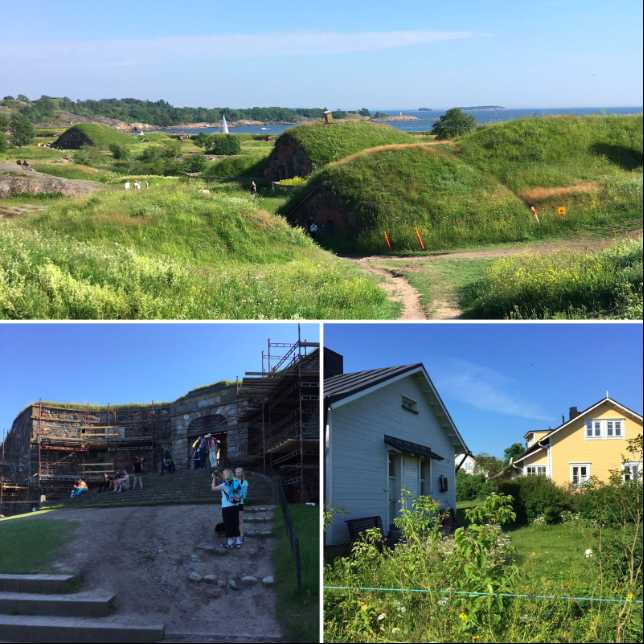
Since the weather was so lovely, we did not visit any of the museums (with entrance fees), but they all seemed interesting and full of content. We saw a wedding couple coming out of the church, we wandered until the main quay and back to the centre quay, then all the way to the South-Western cliffs and down to the bastions. The weapons deposits hidden under hills green with grass looked like Hobbit houses 🙂 it was so cool to see not only tourists, but also locals enjoying a picnic on the grass. We really enjoyed 3-4 hours there, taking pleasure in the scenery and barely scraping the surface of Finnish history, so I believe it would be very easy and interesting to spend a whole day there to dive into it.
A fundamental thing that we should have done was booking dinner in a traditional restaurant. Our last evening in Finland was on the busiest day of the year, we were hungry and tired, and we only knew the touristy area! We ended up at Kapelli, the historical restaurant on the Esplanade, where we enjoyed delicious but very expensive traditional dishes after an excruciating wait – before and after ordering. But where else will you have reindeer steak, if not in Finland? Other good restaurants from Tripadvisor were Ask and Aino, unfortunately either fully booked or too far for our hungry and impatient stomachs. I really should have planned this ahead. Good lesson for the next trip!
Darek and I decided to chase the sunset and a drink, and failed at both tasks. We went to the Ateljee rooftop bar (on top of the Sokos Hotel Torni) but we were late to a probably not impressing sunset over grey clouds between boring buildings and cranes. All the locals had left to spend the Midsummer holidays by the lakes, and a normal cocktail cost between 15 and 20 euros – I can have lunch for a whole week with that in Budapest! Notes for the next trip: stay with Couchsurfers and have drinks at home, or go by boat to Tallinn 🙂
We had one last morning for some more architectural landmarks. We started with the Orthodox Uspenski Cathedral, similar to the Tampere Orthodox Church, with its red bricks, small green domes and intricate geometrical decorations inside. If we had more time, the marina next to it seemed a very relaxing walk. Instead, we walked along the Aleksanterinkatu once more and then north by the Central Railway Station, by the very modern Music Centre, until the Finlandia Hall, one of Alvar Aalto’s most famous projects. I’m no expert in architecture, so that may be why I was not impressed. We did not miss the opportunity to bathe our feet in the Töölö lake 🙂
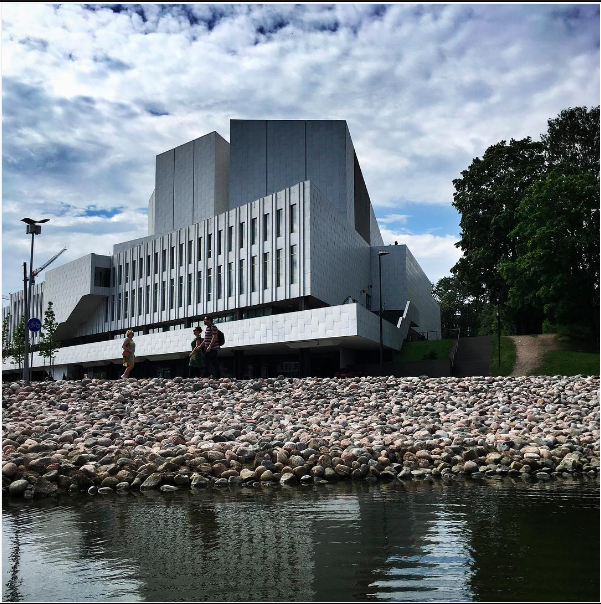
Before taking the bus back to Tampere, we had time for souvenirs! At the supermarket we bought Fazer chocolate and biscuits – a famous Finnish brand founded in 1891 – and on the Esplanade I bought kitchen towels by Finlayson, the cotton mill in Tampere, the perfect memory of the holiday. I was happy to spend a couple of hours in Tampere before taking the flight back. Somehow, the sight of the dark rapids and the red factories felt a little like home.
Conclusions about Helsinki: a beautiful city, but quite expensive (mainly the food) and probably not memorable. 48 hours were enough, perhaps with one more day we would have ventured into other neighbourhoods, outside of the tourist comfort area. If I were not so curious about the Midsummer celebration, perhaps the days of mid-June or early July would have shown us the real Helsinki, with more locals and nightlife, and still the same magical short nights.
Are you planning a trip to Helsinki? Here is what we found useful:
- I downloaded the app City Walks by GPSmyCity.com and never used it. Bad Giulia, it had plenty of information and walks.
- Check the Helsinki Pass: it looks expensive, but if you already plan to visit many of the featured attractions, it is a good deal.
- The public transportation network looks quite extensive and easy to use, but the whole city centre is anyway reachable on foot.
- Take a look at supermarkets opening hours, as an alternative to pricey restaurants
Let us know what you think in the comments! Cheers 🙂
